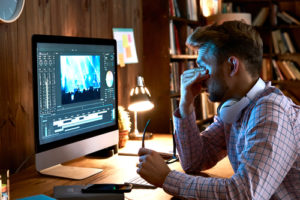
Reduce Glare
Glare is a visual phenomenon that occurs when too much light enters the eye, impairing the ability to see clearly. Glare may involve light streaming directly into the eye, like when headlights shine toward us, or it may involve reflected light. In the home office, glare may stem from the position of your workspace in relation to a window or bright lights. If you cannot move away from windows, close the curtains. Glare can also come from the computer monitor. This can be reduced with an anti-glare screen cover or by adjusting the brightness of the screen.
Adjust Computer Settings
In addition to optimizing the brightness of your computer screen, you can reduce digital eye strain by increasing the size of your font. This can keep you from having to squint to strain unnecessarily. Computer screens emit blue light, which is known to contribute to digital eye strain. You can minimize the effects of blue light by adjusting your settings to “night mode” or “night light.” Finally, it matters where your screen is in relation to your eyes. Your monitor should be arm’s length away and should be at a level just below your eyes. You don’t want to look up at your computer screen.
Take Breaks
We trust that most people have heard of the 20-20-20 rule for healthy eyes. Because we spend so much time looking at screens, this is a general guideline that is beneficial for people of all ages. It suggests that we should take a break every 20 minutes to look at objects about 20 feet away. Just 20 seconds of this practice can help “reset” the eyes. Blinking is also an example of taking a break from digital devices. We often forget to blink when we’re focused on tasks, so this takes a bit of mindfulness. In addition to blinking, it is beneficial to also just let the eyes close for a few seconds now and then. This helps maintain moisture on the ocular surface.
Stay Up to Date With Prescriptions
If you wear corrective lenses, make sure they are regularly updated. This is an easy thing to do when you maintain annual eye exams with your ophthalmologist. Blurriness and eye strain could be signs that your prescription needs an update.
We are proud to serve patients in Skokie, IL and surrounding areas. To schedule a visit, contact us at 847-677-2794.

